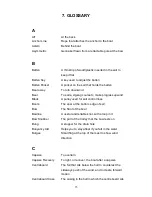
21
7. Hoist the Mainsail using the Main
Halyard. This is a two person job.
One pulls the halyard whilst the
other ‘feeds’ the bolt rope into the
mast track. Care taken at this
point will extend the life of the
mainsail.
Note
: When hoisting DO NOT place the
rope in the cleat. This will ‘burn’ the cleat
out very quickly. Only place the rope in
the cleat when pausing for time or the
sail is full hoisted.
8. Once fully hoisted
tidy away the
halyard into the
pocket on the
spinnaker chute.
9. Slide the black plastic
slug on the mainsail clew
into the track on the
boom.
Summary of Contents for LDC 2000
Page 1: ...1 LDC 2000 Rigging Guide...
















































